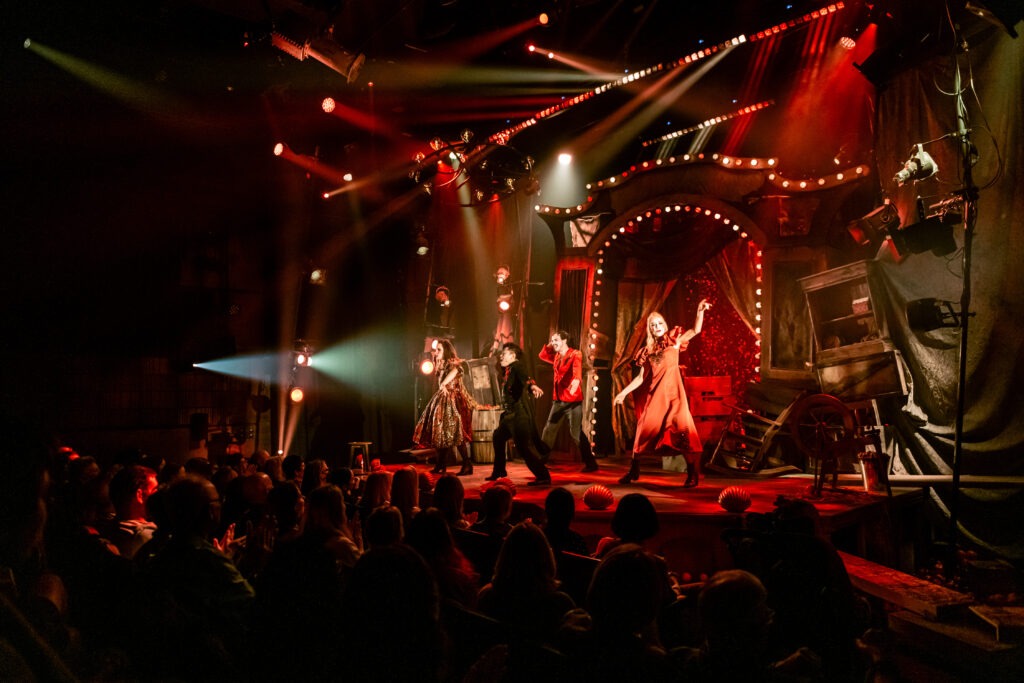
‘Away’ // Villanova Players
‘Away’ was moving.
A slice of the late 60s came to the Ron Hurley Theatre at Seven Hills this week with Villanova Players’ production of the Australian classic play ‘Away’. Written in 1986, but set in 1967, ‘Away’ is the most well-known play by Australian playwright, Michael Gow.
Every drama and theatre teacher in Australia that has been around for more than a decade has come across this play at some stage in their career. Likewise, many theatre directors will have witnessed monologues from this text performed brilliantly or massacred in an audition room. As a text, it is clever and engaging and the topics and themes are as relevant to contemporary audiences as when it first appeared on stage in the 80s. It was refreshing to see the play in its entirety, performed by an accomplished and reputable community theatre.
‘Away’ is the story of three families from the same community heading ‘away’ at the end of the school year. Gwen and Jim are heading off in a caravan with their headstrong daughter Meg, while Harry and Vic are camping with their son Tom, and Roy and Coral are leaving for a Gold Coast apartment for a much-needed break. Each of the families are dealing with tensions and grief as the audience gets ‘let in’ to the struggles and journeys with them on the path to restoration. The play is bookended with two Shakespearean plays: A Midsummer Night’s dream and King Lear. These moments serve as a motif linking the play to the concepts of fate and reality. Life is both comedy and tragedy, just as Gow’s play makes us both laugh and cry.
Villanova Players’ production featured a cast of fourteen, with eight lead roles and six ensemble members. In many productions of the show, the eight leads also double as the ensemble roles. There can be some nice symbolic moments when the show has doubling – for example, the very tense and emotional character of Roy, doubles as the red-nosed clown camper with a ukulele which provides the audience with an insight as to the character’s desire to move forward through his grief. The characters of Tom and Rick are doubled as they both remind Coral of her son, and each of them help her in the grieving process. In this production however, the decision to have six strong ensemble meant that more actors had an opportunity to shine and the group scenes such as the camp fire and the New Year’s dance party were filled out and had greater energy. For this production, it was a nice choice. In the ensemble, Tiffany Dahl playing the character of Leonie, was the standout with her comedic skills and facial expressions.
Meagan Lawson had the challenging task of playing ‘Coral’ — a grief-stricken mother who had lost her son in the Vietnam war and was struggling to cope with the reality of life without her only child. Her husband, Roy (Brent Schon), is the School Principal and needs to maintain his composure and authority in the community. Their relationship brings up the attitudes towards war, grief and loss that were very much part of our culture in the late 60s and the unhealthy way people were expected to sweep trauma under the carpet in the hope that it would simply go away. Lawson and Schon managed this relationship and the complexity of it with the maturity, intelligence and skill that comes from experience on stage. Lawson’s portrayal of Coral was incredibly impressive. Her ability to grip the audience with her authenticity left me searching for tissues. She provided a beautiful contrast to Schon whose powerful voice maintained the status of a principal and a strong man who was concerned about appearances in public. One of the most powerful scenes was when Roy and Coral were packing to leave and Roy dropped his guard and opened up about his feelings over the death of his son. This demanding scene was handled masterfully by Lawson and Schon, leaving the audience with a palpable sense of loss.
The character of Gwen was played by Jane Binstead. Gwen is the martyr mother, who has sacrificed everything for the well-being of her family and would love everyone to know about it. Like all characters in this show, Gwen undergoes a transformative experience. By the end of the second act, she has reaped the benefits of time away and has softened after being exposed to new perspectives from Tom’s parents. From the opening scene, Binstead was ‘on’. She played this classically fun, yet complex role like a polished pro and demonstrated her versatility with her skilful management of the character’s transformation. Peter Cattach, who played her husband, Jim, provided a gentle contrast to Binstead’s controlled, well-articulated and targeted vents.
The two school kids, Tom and Meg were played by Thomas Wood and Emily Summer. Wood’s awkwardness in the intimate scenes with Meg was fitting. Summer delivered a convincing performance and had the audience completely on her side when she confronted her mother. The backwards and forwards exchange between Meg and her mum successfully built tension to keep the audience riveted.
David Schloes and Victoria McCrystal had a beautiful chemistry as Harry and Vic. Schloes looked completely comfortable and natural in his ‘Dad’ role and McCrystal was delightful in her portrayal of the proud, caring mum.
The production team sourced key props and costumes to authentically honour the era the show was set in. A gorgeous caravan set piece, retro 60s fold up sling lawn chairs, flicked hair styles and a-line dresses all helped the show’s cohesiveness. Likewise, director Helen Ekundayo, cleverly used different 60s music in scene transitions to weave together the story that was unfolding before us. The production used projections to amplify the setting, however I felt these were superfluous, as the clever use of soundscape and the vintage props and costume indicated time and place effectively.
The storm in this show is critical to the dramatic action and the transformation of the characters, as it is symbolic of mother nature’s healing qualities thrusting these families together so that their healing can begin. On stage, this moment did leave me wanting for more. The fairies from the opening scene helped create the storm on stage by carefully overturning chairs and objects on stage. To keep the throughline of the Shakespeare from start to finish, it might have been nice if some fairies could have been integrated throughout the other scene changes to highlight fate’s hand in the coming together of these families. Of course, the practicality of costume changes may not have made that possible. These suggestions are minor in comparison to the overall impressive impact of the production.
The quality of the acting in this show was the standout. The humorous moments landed well with the audience, and the emotional scenes were truly captivating. Overall, Helen Ekundayo has done a beautiful job bringing this classic to life and the only truly disappointing thing was that there were still some empty seats in the theatre. Do yourself a favour and go and see a slice of Australian culture and history, told through a moving story in this classic play.
‘Away’ performs until 23rd June at the Ron Hurley Theatre. For more information visit Villanova Players’ website.






